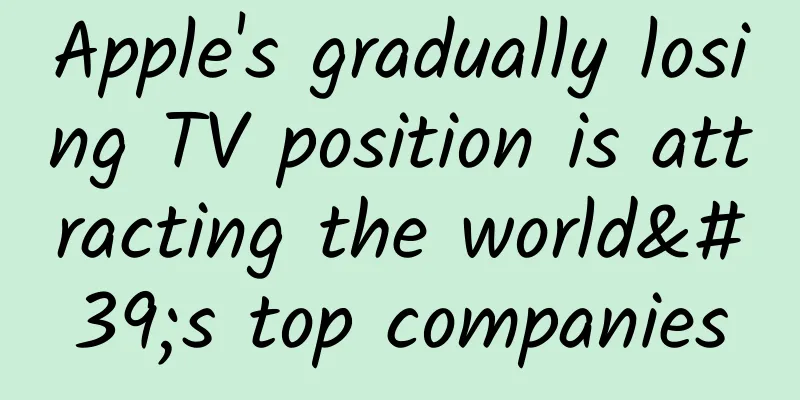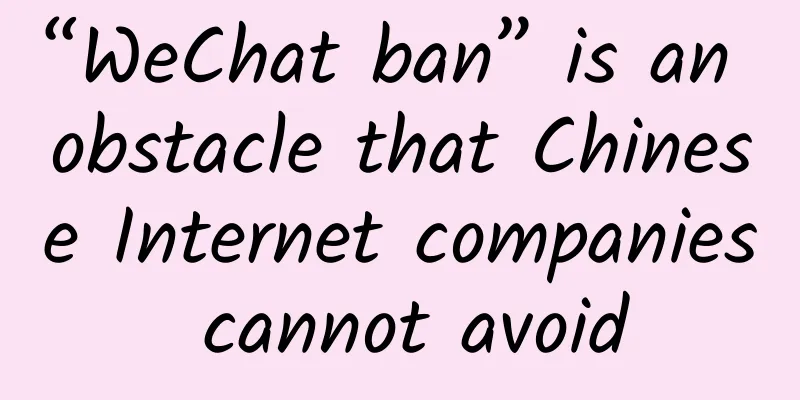Apple's gradually losing TV position is attracting the world's top companies

|
Reed Hastings, founder and CEO of Netflix, an American online video website giant, once predicted: "Within 20 years, all television will be transferred to the Internet, and traditional TV networks will gradually die out like landline telephones." Indeed, the popular online TV is constantly challenging the legitimacy of traditional TV. In the United States, Internet giants such as Amazon, Apple, and Google, as well as streaming media service providers such as YouTube and Netflix, are all making great strides in the online TV field, and a battle for Internet TV has already begun. This issue of Quanmeipai (qq_qmp) sorts out the trends of Internet TV in the United States and attempts to answer the following questions: Why are traditional TV platforms forced to transform? Why are resources and capital flocking to online television? Is this "new TV trend" in the United States an isolated case or a global trend? Born for the Internet: American television industry reshapes the rules of the jungle Some American TV broadcast platforms The television broadcasting platforms in the United States can be described as a "tropical jungle" and are dazzling. However, they can be roughly divided into three categories: the first is free wireless TV programs, the most representative of which are the three old TV networks ABC, NBC and CBS, which mainly rely on advertising to maintain their income; the second is paid cable TV programs, and TV stations such as USA, TNT, FX, and AMC rely on the model of "family subscription + commercial advertising + series DVD sales" to make profits, while TV networks such as HBO, Showtime, and Starz mainly rely on subscription income; the third is online TV represented by Netflix, Amazon, and Sling TV, which broke the bundled model of cable TV. With super high cost-effectiveness, more high-quality and flexible content, they have taken away a large number of TV natives and eroded the market share of traditional TV platforms, especially for young audiences, the stickiness of online TV platforms is becoming more and more prominent. According to data from Statista, a data research organization, in January 2016, 43% of 18-36-year-old subscribers to pay TV services in the United States subscribed to Netflix; at the same time, the older the age group, the more users subscribed to cable TV services, which shows that the cable TV audience is showing an aging trend. Distribution of pay TV service subscriptions in the United States, January 2016 DTVR (Digital Television Research) has predicted that by 2020, the U.S. pay-TV business will suffer a loss of nearly $7.86 billion. Growth or loss of TV subscription revenue in various countries from 2013 to 2020 The cake is being taken away continuously; traditional cable pay TV parties have also realized that the rules of the jungle are being reshaped, and if they do not want to be killed by young lions, the "tigers" must learn to seize new territories. HBO is an American cable television network company that adheres to the concept of "HBO products must be high-quality" and has created a large number of high-scoring film and television works such as "Game of Thrones" and "Prison Break". In March 2015, it cooperated with Apple to launch the HBO Now online streaming platform. For $14.99 per month, you can watch all TV series, movies and documentaries produced by HBO. In February 2015, satellite network operator Dish Networks launched the independent Sling TV service, which can be provided to users' TV, mobile and PC terminals through applications such as Android and iPhone. The package fee for this service is $20 per month, which brings together live content from 19 channels such as TNT, ESPN, CNN, etc. Subscribers can also pay an additional $5 per month to subscribe to additional channels such as HBO. In addition, AMC, FX, and Showtime have also launched online viewing platforms and various App terminals; Sony has also launched PlayStation Vue, an Internet TV that integrates at least 60 channels. However, in addition to the renewal and reconstruction of traditional television forces, what really shook up the television industry were the new giants that entered the market. A sudden rise: an industry leader in online TV In the past year, technology giants such as Amazon, Apple, Google, and YouTube have entered the video market, further squeezing the market share of traditional TV platforms. Amazon: Using e-commerce methods to make TV At the 2017 Oscars, Amazon Studios won three Oscars, each of which showed the ambition of Amazon, a business consortium, to enter the online video business. Looking back to 1995, Amazon was still selling DVDs. Later, it tried its hand at making hardware devices such as set-top boxes and gradually figured out the way. When the time was right, it turned to content. In 2008, it founded the streaming website Prime Video and bought the rights to broadcast a large number of movies and TV shows. In 2010, it established Amazon Studios to focus on the production of original film and television content. More than 20 years have passed in the blink of an eye. Amazon's attempt in the video field has been a great success. The Fire TV launched in 2014 has established a firm foothold in the set-top box market, and the originality of its content has also been recognized by the Oscars. Unlike the TV industry, which relies on "subscription + advertising" to make profits, Amazon, which has its own e-commerce genes, has shown another possibility of business model. In 2011, it launched Prime Instant Video, which packaged original series into the $99 Prime Instant Video (member instant video service), and attracted users to sign up for membership with a large number of free movies and TV series. "After becoming a member, you must buy something," which also complies with Amazon's ultimate goal of "selling one more product." Dave Limp, vice president of Kindle, further explained Amazon's business logic, "Once we have Fire TV, people will buy content, movies and TV shows on demand, as well as Prime services. We prefer to make money when consumers use our products rather than when they buy them." Apple: Staying true to its mission and diversifying its business Former Apple CEO Steve Jobs once revealed his TV development plan to his biographer Walter Isaacson: he wanted to build a more benign TV system and ultimately break the traditional TV user interface. In 2013, Apple's current CEO Cook also said that TV is an area of interest for Apple and that the company has long-term plans in this regard. Even though the two generations of Apple leaders attached enough importance to the TV field ideologically, the actual situation was indeed not satisfactory. From 2007 to 2015, Apple launched four generations of Apple TV set-top boxes, and then there was no new move. The legendary TV set showed no progress. Compared with similar TV box products such as Fire TV, Roku, and Chromecast, Apple TV, which is expensive and has a poor experience, is not as popular as the iPhone it launched. An analyst once said, "Unless Apple innovates more on Apple TV, it may lose its position in the 'living room'." In recent years, as iPhones have been launched one after another, when everyone has almost forgotten Apple's ambition in TV, Apple began to frequently launch big moves in 2017. Timothy D. Twerdahl, former head of Amazon's Fire TV department, was hired from Amazon as vice president to plan the release of the fifth-generation Apple TV; according to the Wall Street Journal, Apple is about to get involved in the film and television production business, and Apple executives told Hollywood that Apple plans to launch its own original TV series by the end of the year; in addition, Apple also plans to sell three high-quality TV channels to users in the form of bundled channel packages. Hopefully, Apple’s TV layout this time will no longer be a game of “crying wolf”. YouTube: What challenges does it face from video to TV? YouTube was once regarded as "Google's dead goose" because all its content was free; in February this year, YouTube announced the launch of a paid live TV and on-demand streaming service called "YouTube TV". "YouTube TV membership is only $35 per month, less than half the price of cable TV," said Andrew Jeon, chief engineer of YouTube TV. "Users don't need to sign a contract and can cancel their subscription at any time." In addition, this service allows users to watch content from more than 40 TV channels including ABC, Fox, CBS, NBC, Disney, ESPN, etc. through mobile apps. It supports pushing to TV via Chromecast and watching on 3 devices at the same time. The news that Google is accessing live TV content seems a bit sudden, but Neal Mohan, chief product officer of YouTube, revealed that Google has been secretly preparing for the launch of YouTube TV for more than two years. Going back a little further, YouTube TV can be regarded as a product that Google has been planning for seven years: as early as 2010, Google released the first generation of Google TV. At that time, Google's goal was to "let users cut off cable TV and watch any TV program they want to watch." At that time, the sales of this product were mediocre and did not receive much attention. YouTube CEO Susan Wojcicki said, "YouTube TV is a product that targets young people and provides them with content that interests them in a more flexible way." It seems that the migration of young users from YouTube to YouTube TV is a natural process. Netflix: Continue to invest heavily in creating more "House of Cards" 2017 is destined to be a turbulent year for Netflix. It announced that it will invest $6 billion to create original content, while the investment amount in 2015 was $4.9 billion. In comparison, Amazon's original content investment in 2017 was $4.5 billion. Netflix and Amazon’s annual original content budgets Why invest so much? The competition in the Internet TV business is fierce, and Netflix needs to keep creating more "House of Cards" to maintain its advantage. So far, Netflix has the highest market share. The latest statistics released by market research agency comScore in April show that among OTT business subscribers, users who choose Netflix services account for as high as 75%; Zacks investment agency data also shows that Netflix has more than 80 million members in 2016. OTT service subscriber engagement and reach Number of Netflix subscriptions in 2016 Why does Netflix have an advantage among Internet TV users? In addition to high-quality original content and comprehensive content services, Netflix's textbook methodology can indeed be written into a book. For example, the user experience of no advertisements and "Binge Watching" (watching several episodes in one go) is excellent; or the use of big data to accurately calculate the preferences of netizens and create popular dramas. Long before the release of "House of Cards", Netflix executives had already predicted that "this drama will be a hit." Why is this "TV trend" blowing across the ocean? Today, the functions of television, such as transmitting information, providing entertainment, and relieving loneliness, are constantly being replaced by more interesting and new things. The scene of a family waiting in the living room to watch TV series seems to be less and less common. However, the "new TV trend" that has swept across the ocean has not only allowed people to rediscover the fun of the living room, but is also providing entertainment services to users in new ways. Broad profit imagination Some people may ask, what is the motivation that attracts so many Internet giants to enter the TV industry? Profit imagination is of course the most important reason. Take Netflix for example, in 2016, Netflix's annual revenue was 8.83 billion US dollars and its net profit was 187 million US dollars (the net profit in 2014 reached 267 million US dollars). Unlike ordinary video websites or cable TV, Netflix's profit is concentrated on user subscriptions. YouTube CEO Susan Wojcicki also pointed out that for the development of TV business: "The company is not worried about whether it will be profitable in the short term. For new products entering the market, we usually focus on: Are we solving real problems? Is this something we care about? If we succeed, can we change anything?" In addition, advertising is of course also a major source of income for Internet TV. But the future advertising business will appear in a completely new look, just as Wojcicki said, "The advertising-supported TV industry is one of the largest industries in the world. We found that there are many aspects of the experience that can be done better: search, recommendation, cloud storage. For an Internet company like Google that is based on advertising, this is a good investment." In her opinion, today's TV advertising business is not humane enough, and in the future Internet TV will provide advertisers with more quantitative and accurate advertising services. In addition, the rapidly expanding international market has also brought new momentum to the profitability of the Internet TV business. According to a report in January 2017, Netflix added 7.05 million new users in the fourth quarter of 2016 (3.57 million new users in the third quarter), of which 1.93 million were in the United States and 5.12 million were in the international market. For the United States, which has a population of 300 million, 50 million local users are close to the saturation point of the domestic market, but the growth space in the international market is still huge. Of course, companies like Apple and Amazon are also making profits by manufacturing hardware products like Apple TV and Fire TV. Create a new living room entertainment ecosystem Whether it is Apple, which is optimistic about smart home life, or Amazon, which has the ambition of "full coverage from A to Z", entering the video field and seizing users' living rooms are an important part of their strategic layout. For example, Apple hopes to bring more TV services and corresponding consumers into its own ecosystem. To this end, Apple continues to strengthen product and service research and development, while also creating self-made content. More Internet giants believe that developing the TV business is a natural progression based on existing businesses, as YouTube Chief Product Officer Neal Mohan said: "We have been discussing the concept of integrating the best TV content and the best YouTube content. We hope to become the integrator of all video content." Wojcicki said: "These two different media have been developing on different parallel paths before, and they have been getting closer and closer. This will be the ultimate fusion." More imagination is focused on the "living room economy". When people are attracted by smart TV services, there should be more room for imagination: for example, combining with more needs such as education, games, shopping, and resonating with new technologies such as virtual reality, augmented reality, and artificial intelligence. For example, Google and Amazon have launched smart speaker products to lay out the living room economy; in the future, TV will also be an application carrier for AI technology to further develop its strength, and continue to extend the core of intelligence, interconnection, and ecology. But risks and challenges coexist Of course, the Internet TV business is still in its rising stage, and there are still many problems ahead. For example, the sustainable production of high-quality content and the high cost of video copyrights are important factors affecting the rapid rise and profitability. Today, platforms such as Sling TV and Play Station Vue are providing users with some programs from all TV channels through the Internet at a price lower than that of traditional cable TV packages, but as Dan Rayburn, an analyst at consulting firm Frost & Sullivan, said: "No one is making money" and "these services are priced too low to support the purchase of high-end programs from network companies." He emphasized: "I don't think this is a successful business model. Without the backing of the parent company, these services cannot be sustained." Recently, Netflix also revealed that it will introduce the science fiction action film "Bright" starring Will Smith, and paid $90 million in copyright fees for it, while the production cost of the film was $45 million. In addition to the fact that Internet TV is a track that requires a steady influx of money, the clarity of the profit model, the establishment of barriers by competitors, the sales rate of smart hardware, etc. are also difficult problems facing Internet TV players. But no matter how many thorns there are ahead, the vanguard has already set out, and will use smart technology and new business models as their spears to reach the other side full of users. As a winner of Toutiao's Qingyun Plan and Baijiahao's Bai+ Plan, the 2019 Baidu Digital Author of the Year, the Baijiahao's Most Popular Author in the Technology Field, the 2019 Sogou Technology and Culture Author, and the 2021 Baijiahao Quarterly Influential Creator, he has won many awards, including the 2013 Sohu Best Industry Media Person, the 2015 China New Media Entrepreneurship Competition Beijing Third Place, the 2015 Guangmang Experience Award, the 2015 China New Media Entrepreneurship Competition Finals Third Place, and the 2018 Baidu Dynamic Annual Powerful Celebrity. |
<<: Ferrari experts come to Zotye Auto to build Ferrari?
>>: If Lexus is now produced domestically, how much stage can Chinese consumers give it to perform?
Recommend
You can earn over 10,000 yuan a month by operating the knowledge payment CPS distribution project with the official account
People often add me on WeChat and ask what good m...
Three sisters who didn't smoke got lung cancer one after another! This is very important, but many people do it wrong
Expert of this article: Hu Zhongdong, deputy chie...
Why iOS 15.2 must be upgraded? You will understand after knowing these three points
[[441480]] In addition to the "metaphysical&...
Is it cheap to rent a BGP server room?
Is it cheap to rent a BGP server room? The BGP co...
Back to school season | As a study partner, does the eye protection lamp really protect your eyes?
...
A guide to the counter-trend growth of self-media in 2018!
2018 has passed so quickly that the New Year’s Da...
1-year-old baby died of poisoning! This thing is in almost every household! Be careful!
For Xiaoxi (pseudonym), a 1-year-and-4-month-old ...
Lee Smolin: Finding a way beyond quantum mechanics
Quantum mechanics is the most successful scientif...
Can I use a photocopier to print money? (What a punishment!)
Easter egg: I found a young man who spoke out the...
Experts point out four major problems in home kitchens. Are you affected?
Data shows that the oil and salt intake of Chines...
Helping you grow hair VS causing you to lose hair, here is the "contradiction" of androgen →
When we see someone with abundant body hair, we t...
The formula for creating popular educational short video content
As an account operator, I pray for the birth of a...
Today is Laba Festival丨The Laba garlic turns green, is it really spoiled?
Today is the eighth day of the twelfth lunar mont...
Why does MCN do live broadcasts without selling products?
In the recent live broadcast, there is a breath o...
It’s time for the “Queen of Fruits” to show off again, but I really don’t recommend you to “praise” it
Mangosteen is known as the "Queen of Fruits&...









